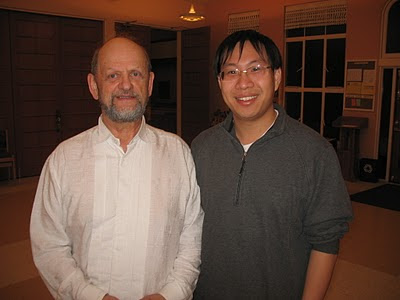03/25/2011
Matthew Locke: Fantasie Suites in C minor and C major
Christopher Simpson: Duo Divisions in F and G
Ste. Colombe: Concert for two gambas "Tombeau Les Regrets" and "Le Raporte"
Marin Marais: Suite in G for two gambas and continuo
Antoine Forqueray: Excerpts from Suite No.5 C minor for gamba and continuo
Christoph Schaffrath: Duet for 2 viola da gambas in D minor
Wieland Kuijken, viola da gamba
Lynn Tetenbaum, viola da gamba
Katherine Heater, harpsichord
(本該在回台灣前完成的,不過拖到回來才寫好…)
當代最資深的viola da gamba提琴手,該是Jordi Savall和Kuijken三兄弟裡的Wieland Kuijken了。Jordi Savall在古樂裡超級巨星的架勢,去年五月有親自目睹。出道較早的Wieland,反而沒任何巨星的光環。小小的教堂,位子沒有坐滿,到音樂會現場才買票,一點問題都沒有。我猜,可能是因為兩週前同樣的concert series才剛表演gamba的曲目,這次又是古中提琴,觀眾或許可能吃不消吧 ~~~
Kuijken這一天的曲目,涵蓋了古中提琴各重要時期和地區的音樂,先從英國巴洛克早期的Consort Music,到法國巴洛克中期的St. Colombe與Marais和Forqueray,以及巴洛克晚期的德國作品。似乎不想太流於世俗,巴哈有名的古中提琴奏鳴曲不在演出曲目上。
上次的Hallifax&Jeffrey音樂會清一色英國的曲目裡的主角Simpson,這場音樂仍有他的音樂,不過這次給兩支gamba的divisions變奏曲難度似乎更高,Kuijken的學生Lynn Tetenbaum有幾段漏掉不少音,Kuijken本身也不能幸免。
但,這天的重頭戲其實是放在法國的這幾位作曲家上面。St. Colombe的音樂,是裡面我比較不熟悉的,一大部份的印象來自於電影裡「日出前讓悲傷終結」,其中Savall的錄的音樂都相當哀愁。不過,這天Sainte-Colombe的這首組曲,對我來說意外地動聽,也是整場音樂會裡我最喜歡的一首。另一首組曲,雖然同時有Passacaglia與Chaconne兩種我喜愛的曲式,但音樂主題不鮮明而顯得冗長,沒能留下深刻印象。Marais那一首組曲,則是在陽光的Chaconne之後,緊接著是Tombeau de Monsieu Meliton,黯然地結束上半場。
最讓人大開眼界的,是Forqueray那首gamba組曲精選(太長了,沒時間拉整首)。他的古中提琴組曲可能是為此樂器寫過最困難的音樂,一般的古中提琴家沒有多年的底子,是不可能輕易嘗試的。由於他的兒子有將這些曲子改編為大鍵琴版本,所以我對這些音樂的認識來自於那些大鍵琴曲。C小調的第五首組曲,大鍵琴版本就已經相當有挑戰了,而原本的古中提琴版,更是難上加難。如沒有在現場,還沒能真正見識到。音又多又迅速的橋段(runs),加上許多和絃,常常是三絃,讓年事已高的Kuijken(七十多歲了),也吃了不少螺絲。組曲最後一首有Jupiter的標題最生動,描寫朱彼得天神雙手不斷地拋出閃電。
經過Forqueray的大考驗,最後一首是德國Schaffrath的一首雙gamba二重奏,風格是巴洛克晚期,古典樂派早期的音樂。說穿了,是最平易近人的旋律和音樂,但問題就在沒什麼太大的特色。三個樂章聽下來,只讓我感覺是淪落成那時期的眾多不顯眼的曲子之一。只能說,對於我,音樂並不是在高潮上結束的~~~
Kuijken和之前的Hallifax&Jeffrey給我最大的不同,是他在演奏上強而有力的自信,從每個音到每一句都感覺得到。另外,Kuijken的抖音用得相當多,是我之前有點沒預料到的,連他的學生Tetenbaum在抖音上的使用率,都比他低。有近六十年演奏經驗的大師,對於古樂的表演方式,有自己堅信的理念,沒有所謂絕對的「歷史正確性」,只有當下「正確音樂性」。
音樂會之後,當然不能放過請他簽CD還有留影的機會。其中,剛好有他和在下大師祖Leonhardt錄過的Forqueray這首第五號組曲。看看錄音年代,竟然是四十幾年前的產物! 今天已經年過七十高齡的Kuijken,威猛大不如前,但gamba這種樂器,不知為什麼,和這種有年紀的大師,卻似乎又是一個絕配的畫面。
後來,有一位在高科技業工作的中年人,是業餘gamba家,秀了一下他在練的Forqueray第三首組曲最後一首Chaconne,La Morangis ou la Plissay。這剛好是我練過的唯一Forqueray曲子之一,不過一說出來,反而被Kuijken大師酸一句說:「much too easy on the harpsichord..... 」

Maestro Wieland Kuijken
This night, I had the pleasure of hearing one of the two most legendary viola da gamba player perform live, the other being Jordi Savall. Wieland Kuijken doesn't seem to conjure the superstar status that Savall has been able to do. Being much more low-key person, this meant that I was very fortunate to get last minute tickets to the concert at the First Lutheran Church nearby.
Kuijken's concert tonight spans pretty much all the major gamba genres, starting from early English viol music, to the French, and ending in the late German. By eschewing Bach's famous gamba sonatas, Kuijken effectively gives the audience a taste of other good but neglected works written for the instrument.
Following more or less a chronological order, Locke and Simpson represent the English composers. Simpson's two duo divisions has its share of virtuosic passages, and both former student Tetenbaum and Kuijken had their moments of missed notes.
Moving on to the more interesting French composers, which comprise of the majority of the night's program, Kuijken samples through works by Sainte-Colombe, Marais, and the slightly later Forqueray. Of these three, I'm least familiar with Sainte-Colombe's music, that coming vaguely from the film "Tous Les Matins Du Monde." I remember St-Colombe's music played in the film was deliberately chosen to be very sad, as the St-Colombe character in the film said something along the lines that music was a communication pathway between the living and the dead.
Well, surprisingly, the first St-Colombe suite turned out to be one of the most enjoyable pieces of the concert for me. The slower pieces were sensuous, the fast ones equally idiomatic. The second St-Colombe suite contained a passacaille and chaconne, my favorite dance suite forms. This time however, they failed to leave any big impressions on me. The beginning motive wasn't particularly catchy, and the development seemed to be wandering in the same mood. Somehow I was expecting more to happen that never did. Maybe that was just St-Colombe. Selections from the Marais suite concluded with a tombeau, ending the first half of the program on a really somber mood.
The second half opening was a continuation of the French program in selections of Forqueray's fifth gamba suite, the same piece that Kuijken had recorded with Leonhardt 40 years ago. Forqueray's music exists in two forms today, that of the original gamba version and the other for harpsichord, arranged by his son Jean-Baptiste (and allegedly his wife, who was a great harpsichordist). An amateur harpsichordist, I've been quite familiar with the harpsichord versions. However, the original gamba versions are extremely difficult, so hard that some places are said to be borderline unplayable. If I hadn't seen Kuijken play it live, I would have easily taken a lot of the parts for granted, as playing the chords on the keyboard is certainly a much easier task! Kuijken certainly got quite a good workout, as some of the runs and chords seemed to throw him off at times. The last movement of the suite, Jupiter is supposed to depict the thunder god throwing thunderbolts. Even the transcribed harpsichord version is already considered challenging, one can only imagine the hell a viola da gamba player goes through.
Schaffrath's duetto for two gambas wrapped up the concert. It is written in the late Baroque, early classical style, one which I can find uninspiring at times. It was well-played, but the music was not my cup of tea. In fact, it was so pleasing and easy on the ears that nothing felt particularly special. It was like a mild mouthwash to rinse out the strong flavor in the food you just ate. What you are left afterward is that generic "mint freshness."
So what struck me the most about Kuijken's playing? Two things stood out the most. First was the amount of vibrato that he employed. He used quite a bit of it, even more than Tetenbaum, to add color to the sound. Not sure if this was an evolving thing over time, as I need to return to the recordings in detail. The second was his confidence and poise in shaping each musical line and gesture, that it all looked and sounded convincing. I suppose when you do this close to 60 years, nothing really seems misplaced.
The viol won't be my favorite instrument anytime soon, but Kuijken's performance will sure stand out as one of the most memorable ones.

No comments:
Post a Comment